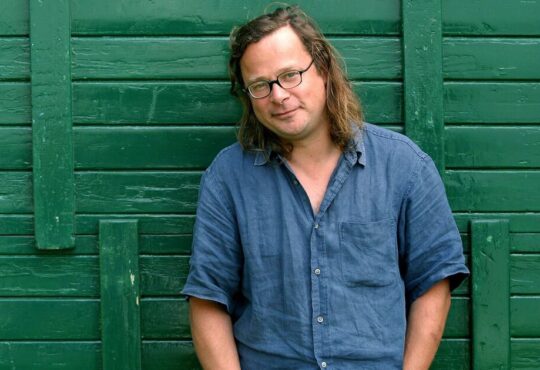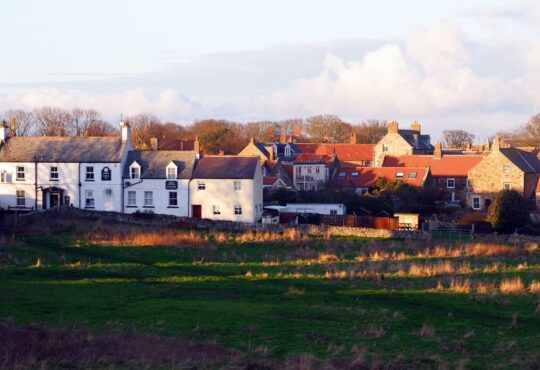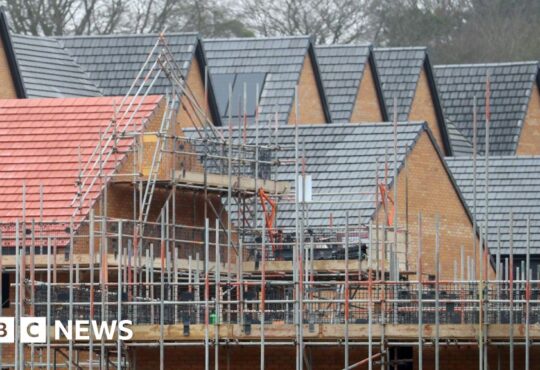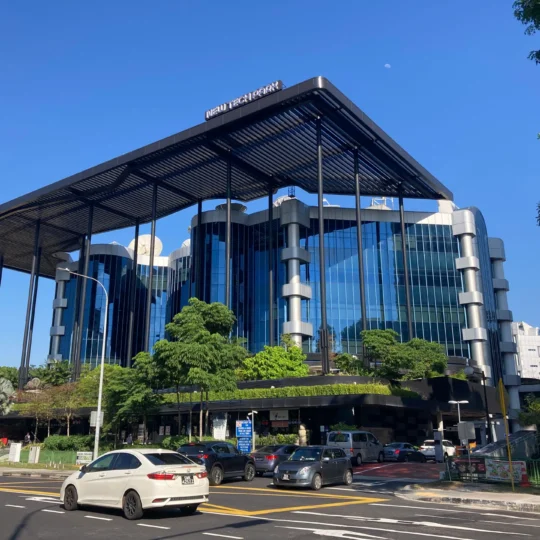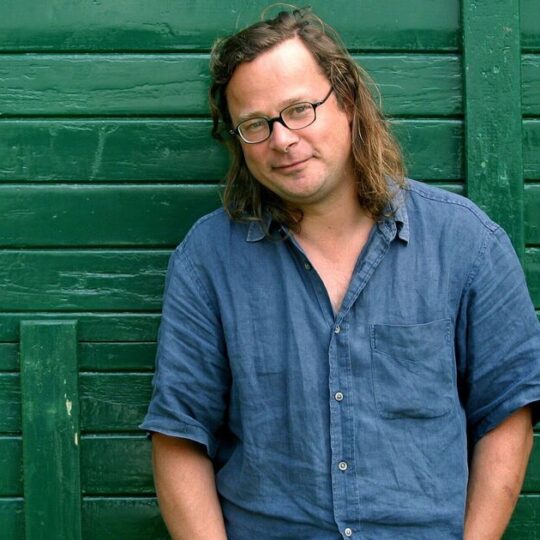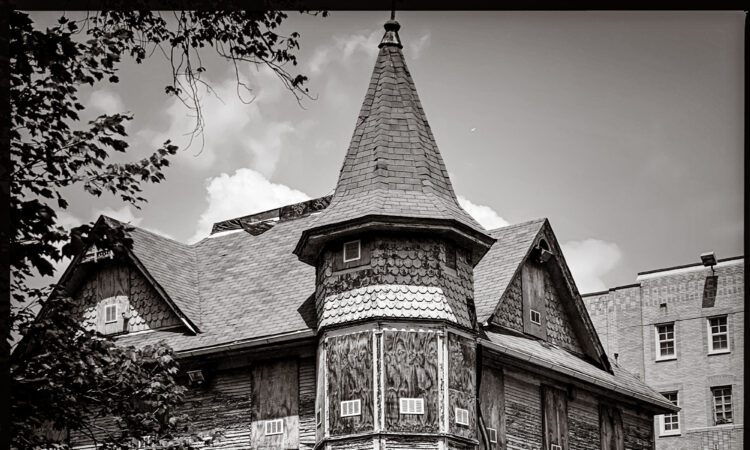
There’s a charming old farmhouse in Northeast D.C. that you probably don’t know about unless you live nearby. The two-story wood frame building is tucked behind a grandiose art deco religious college, invisible from any public roads. It sits at the end of a 300-yard driveway on a quiet, woodsy 22-acre lot filled with mature trees and overgrown vines.
The property at 14th and Shepherd Streets NE is owned—and currently unused—by Howard University. Local historians and preservationists refer to this 140-year-old home as the Sherwood Farmhouse, after James Lewis Sherwood, who originally had it built in 1885 and lived there with his family for more than 30 years. Despite boarded-up windows, peeling exterior paint, and some graffiti on one side, it is largely intact. This farmhouse has survived thanks to practical necessity, happy accidents, intentional preservation efforts, and interracial citizen activism.
The following is a story about the farmhouse, which has been compiled from old newspaper databases, the People’s Archive at the DC Public Library, historic maps, family photos, a memoir, a daily dairy, interviews, including with a descendant of Sherwood, and other archival material.
***
The list of Sherwood Farmhouse inhabitants reads like a micro history of D.C.: a prominent White agricultural family responsible for many buildings in and around present-day Brookland, Catholic nuns serving Franciscan students and educators, radical Jesuit activists fighting against nuclear weapons, and, in its most recent iteration, justice-minded Black theologists. Since 2015, Sherwood Farmhouse has stood vacant, as does the Holy Name College building that hides it from the public’s eye.
The site’s early histories are not ones to be nostalgic about. Even before the farmhouse was built, George McCeney lived on and farmed the land in 1860 (whatever structure he lived in no longer remains). Tax records enumerate his property as “14 slaves, 50 cows and 7 horses.” McCeney was required to free the humans he owned after the passage of D.C.’s 1862 emancipation law. In turn, he petitioned to get government compensation for his “losses.” A heart-wrenching document known as an emancipation petition lists his human property and includes a description of 62-year-old Jeremiah Hall as “worth 250 dollar a year which is the wages I have to pay for one inferior to supply his place.”
The property changed hands a few more times over the next two decades, but no one left as lasting a mark as Sherwood, who was born in Alexandria, Virginia, the same year as D.C.’s emancipation law. Sherwood’s parents, White Union sympathizers, made a modest and unstable living as farmers, produce vendors, and grocery store owners, and they sometimes sold their wares from a horse-drawn wagon. There is no evidence they ever owned slaves.
In a short 1936 autobiography, he writes: “I remember well my father putting me up on a bench by the side of a pile of water melons and telling me to call out: ‘Watermelons. ten cents apiece.’ I must have been about eight or ten years old then.”
According to the same autobiography, the family moved to D.C. proper in 1876. A series of business successes improved the family’s economic standing, so they relocated to a farm in Brookland, then considered the suburbs. Still, Sherwood describes a hardscrabble life: “There were only about 5 or 6 houses in sight at that time. My Father and Mother and all the children worked long, hard hours.”
In 1883, at age 21, Sherwood married Rose Lord, according to his autobiography. She came from a wealthy merchant family. Together they saved up to move out of their parents’ homes, and in 1885, Sherwood bought 14 and a half acres, enough to start a farm, and secured a building permit. The architect and builder of the two-story farmhouse is unknown, but Kim Prothro Williams, architectural historian at D.C.’s Historic Preservation Office, tells me it was common in those days to build from a predesigned template, known as a “pattern book” or “kit” house.
Sherwood chose the fashionable Queen Anne style, with period-appropriate details like a wraparound porch and overhanging roof lines. Although not considered ostentatious, Sherwood appears to have had enough money to add some flair: patterned wood shingles, decorative trim, and a corner tower with a six-sided, castle-like roof. In his autobiography, Sherwood says that the young couple moved into the completed farmhouse in September 1886 and that all their future children were born there. At the time, this area was considered part of Washington County: rural, agricultural, and home to what Sherwood describes as “country people.”
The architecture, while charming to contemporary eyes, is very similar to other farmhouses built around the same time. According to Prothro Williams, it’s the story of Sherwood Farmhouse that makes it special. The Queen Anne farmhouses that still remain in D.C. were all at some point moved and integrated into city blocks, losing their original rural character. Other homes of a similar style were actually “country houses for the affluent,” she explains, inhabited by people who liked the country aesthetic. Because Sherwood Farmhouse was actually owned by a farmer who toiled on the surrounding land, “there really isn’t anything else like it in D.C.,” she says. Brookland native and local historian John J. Feeley Jr. tells me: “When you look at [it], you can’t get much closer to what it was like to be in Brookland in 1890!”
***

Until the end of the century, Sherwood and his family ran a market stall, the same one he’d worked at since he was 14. They used horse-drawn carriages to bring their wares from the farmhouse to downtown. An article in an unknown newspaper praised the foods he grew: “The quality of his fruits, vegetables and poultry received recognition and Supreme Court Justices, Senators and other high dignitaries came to depend on him to supply their tables.”
Still, his neighborhood was largely undeveloped and sparsely settled. In a short history of a local church he helped establish, Sherwood described the roads into town as “so bad in the early Spring that horses could hardly pull their feet out of the clay.”
Population growth and the establishment of the Catholic University of America in 1889 began to change the character of the neighborhood, bringing new streetcars, railways, institutional buildings, and paved roads. In 1897, the Roman Catholic Order of Franciscans purchased land adjoining the farmhouse property. By the end of the century, they had built a large complex with a monastery and replicas of chapels in Jerusalem, attracting priests, friars, monks, and tourists. (The Franciscan Monastery is still open to the public today.)
By 1900, D.C. had a larger percentage of African Americans than any city in the nation. That same year, the U.S. census lists Sherwood as a “truck gardener” with two Black men living at the farmhouse: 28-year-old Walter Gibson and 24-year-old Ernest Easel. The census indicates that both knew how to read and write. Their relationship to Sherwood was listed as servants and their occupation as farm laborers. Jonah Johnson, a 22-year-old Black laborer, was listed in the 1910 census as a driver living on Sherwood’s property.
Were Gibson, Easel, or Johnson descended from enslaved people who farmed the same land before emancipation? It was not uncommon for Black people to stay connected to the White landowning families who enslaved them, but we can’t be certain. There is one promising hint for Johnson: An 1862 emancipation petition lists John Barnes Johnson as a 24-year-old “light mulatto” valued at $1,200 and living on site. When Jonah Johnson lived with and worked for Sherwood, John Barnes Johnson would have been 48 years old. It’s unclear whether they were related.
We also don’t know if Sherwood’s Black staff lived inside the farmhouse or in a separate structure. In post-Civil War D.C., it was common for Black laborers to live in inferior housing on White-owned property. Indeed, one surviving photo shows a small one-story building that has not been identified nor does it survive—this could have been a secondary dwelling. It appears on some historic maps as well.

What is certain is that the lives of their Black staff involved far less leisure than Sherwood’s children. Census records indicate that in 1910, there were four Sherwood kids living in the house, ranging from 11 to 21 years old. One of Sherwood’s daughters, Ruth, describes in her diary “learning to drive a horse,” having “a grand time” on trolley rides from Brookland, going “up on top of the house to see the fireworks at night,” and “coast[ing] down the front hill” in the snow.

In middle age, Sherwood shifted into banking and real estate, taking advantage of the development around him. He and his brother, Jesse, made good money as some of the earliest and most prolific developers in Brookland. In an addendum to the autobiography, Jesse took credit for “lay[ing] out streets in Brookland area using his own team of mules and equipment.” Their work is visible across the neighborhood in the form of homes, churches, and a former movie theater that is now a CVS at 12th and Newton Streets NE. He later became a prominent member of his community—the Washington Post even published a photograph of his 50th wedding anniversary in 1933.
A small but game-changing decision Sherwood made in 1919 contributed to the home’s long-term survival. At age 57, Sherwood sold the farmhouse and adjoining land to a community of Franciscans. By then, Brookland was lovingly called “Little Rome” due to all the Catholic institutions moving to the area, and since Sherwood’s land butted up to the existing Franciscan Monastery property, it made sense to expand their footprint.
***
Having religious owners meant that the lot was designated for institutional use only, and future city roads that began to crisscross Brookland never sliced through the property. As a result, the farmhouse has remained surrounded by undeveloped land: 14th, Shepherd, and Randolph streets NE all dead end at this parcel to this day.

After holding on to Sherwood’s lot for almost a decade, Franciscans began construction on Holy Name College, a center for religious training. A 1929 article from the National Catholic News Service described the location as affording “absolute seclusion and privacy,” and a 1933 Post article praised “plenty of lawns” on a property that was still “within 15 minutes ride by automobile” to Downtown.
The farmhouse assumed a new life as a home for nuns who did the cooking and cleaning for the male students and faculty. It’s unclear when the religious sisters stopped inhabiting the farmhouse: I’ve found almost nothing about those years, possibly due to gender roles limiting nuns’ public life.
The Franciscans came to be known for their commitment to social justice. In 1957, they hosted a celebration of a formerly enslaved saint, an event covered in Black newspapers across the country. Still, enrollment at the college peaked that very same year, and the farmhouse stood empty—and would remain so for two decades.
During the 1950s and 1960s, the unused farmhouse was saved by multiple instances of citizen activism. Racist city plans to eliminate “obsolete” or “blighted” neighborhoods included several planned expressways that either abutted or came within blocks of the farmhouse and college. (Southeast D.C. fell victim to these plans.) The city had already condemned some Brookland homes when residents from across the city formed a committee to halt construction. Black leaders in Brookland rallied to oppose “White Men’s Roads thru Black Men’s Homes” and joined forces with wealthy White residents from upper Northwest who also would have suffered under the proposed plans. It was a season of dramatic upheaval, the city still reeling from Martin Luther King Jr.’s assassination and the ensuing riots.

In 1965, a different Catholic religious order, the Jesuits, elected a radical new leader, Pedro Arrupe. He decreed that “promotion of justice is an absolute requirement” of the faith. To expand their presence in the nation’s capital, the Jesuits opened a national headquarters in a renovated embassy near Dupont Circle. Daniel Sheehan, who served as the legal counsel for their Office of Social Ministries, recalls how he objected to the location: “This is a carpeted, chandelier-ed big mansion that the guys are living in. … They’re being waited on hand and foot by … Black ladies in maid’s suits. … This is not consistent with the social ministry.”
Father William J. Davis, director of the office, went scouting for a more modest location. When he found the disused farmhouse, Holy Name College’s enrollment had declined and both the school and farmhouse needed extensive repairs. Six Jesuit staff members, including Davis and Sheehan, rented the whole farmhouse from the Franciscans for only a few hundred dollars and committed to repairing and restoring it. A resident priest with carpentry skills turned a confessional booth into a bathroom, fixed up rotten exterior stairs, and painted the entire facade red. They renamed it Arrupe House in honor of Pedro Arrupe, and it became their base of operations.
The list of activists who stayed at or visited Arrupe House is a who’s who of the Vietnam War-era: Anti-war resister Daniel Berrigan was on the FBI’s “Ten Most Wanted Fugitives” list for burning draft files. Prominent pediatrician Benjamin Spock was arrested multiple times protesting the Vietnam War. Fierce advocate for the unhoused Mitch Snyder, and Father James L. Vizzard, who worked with Cesar Chavez in California to lobby on behalf of the United Farm Workers union, both stayed there.

Credit: Darrow Montgomery
At the farmhouse, Sheehan and his team worked on the famous Karen Silkwood case. She was a nuclear facility worker and union leader who suffered from plutonium contamination and died under suspicious circumstances. After winning a landmark settlement, Davis, Sheehan, and collaborator Sara Nelson founded the Christic Institute in 1980 to continue their legal advocacy. Christic Institute staff joined the Jesuit radicals at Arrupe House, all of whom would live, organize, and strategize on-site until 1992. Meetings happened on the first floor, with discussions and planning sessions running late into the night. Sheehan recalls: “We were viewed as the most political religious community that anybody knew. [Father Pedro] Arrupe loved us.” Nelson and Sheehan later became a couple, much to the chagrin of their Jesuit—and celibate—housemates.
Over its 15-year existence, Christic Institute represented survivors of nuclear disasters, supporters of Central American refugees, and the first Black mayor in the Mississippi Delta. They prosecuted murderous KKK members and unmasked CIA collaborators in the Iran-Contra Affair. Coretta Scott King, MLK Jr.’s widow, once described the “courageous men and women of the Christic Institute, who have worked to expose the truth about U.S. foreign policy despite threats and attempts at intimidation.”
But around this time, things began shifting for the next-door neighbors of Arrupe House. In the 1980s, some Franciscan friars expressed shame at the grandiosity and scale of the Holy Name College building, seeing it as not befitting their mission. The long driveway was embarrassingly described in a 1981 Post article as “longer than the one that once led into Nelson Rockefeller’s estate.” So by the time Howard University approached in 1983 to purchase the site, Franciscan leadership was ready to sell.
***

Howard University acquired the whole complex in 1984. Jordan Catoe Strudwick, Howard’s deputy director of communications and archives, says via email that one factor in the university’s decision to buy the property was “the distinctive role that Holy Name College played in pioneering social justice causes during the mid-twentieth century, such as promoting the inclusion of African-Americans into the church as both members and clergy.”
Howard undertook $4 million worth of repairs and moved the 120-year-old School of Divinity on-site. This was an era of expansion for Howard, with Holy Name College and Sherwood Farmhouse adding to their list of properties and coming to be known as East Campus. This parcel was now inhabited by Black preachers, former aides to MLK Jr., and a growing Black middle class. By this time, surrounding Brookland had long been majority Black. Prominent diplomat Ralph Bunche grew up nearby, and the first poet laureate of D.C., Sterling Brown, hosted literary salons there for decades.
Howard allowed the Christic Institute to continue its operations at Arrupe House, but the arrangement only lasted about eight years because Christic’s radical reputation eventually contributed to its demise: A 1989 book by a staunchly conservative writer described the organization as anti-American terrorists, and the Internal Revenue Service stripped its nonprofit status a few years later.
In an interview, Sheehan recalls the group’s last night at Arrupe House in 1992. The Christic Institute staff learned that a right-wing judge planned to seize all its files in connection with a federal libel suit. The team frantically packed up case documents and fled D.C. altogether, he says. They temporarily hid the files from Arrupe House at the ranch of famous American musician Jackson Browne.
Howard later converted Arrupe House into the Divinity School’s Office of Institutional Research, which stayed on-site until 2015, when aging infrastructure led it to relocate.
It wasn’t until 2013 or so that Emily Morrison, one of Sherwood’s great-granddaughters, learned about the farmhouse. She was even more surprised to learn that it still stood, and only a few minutes’ drive from where she lives. While excited about her discovery, Morrison was also disheartened to see the farmhouse’s condition after Howard moved out.
“People were crawling in by prying windows open, office equipment strewn around, animals were going in,” she says. That same year, the DC Preservation League nominated both Holy Name College and the Sherwood Farmhouse as historic landmarks, later adding the farmhouse to their list of most endangered sites in 2022.

Pressure from Morrison, community members, and preservationists pushed Howard to stabilize the farmhouse: The university removed anything subject to rot and boarded up all the windows while leaving vents for airflow. Neighbors used to freely walk their dogs on the leafy grounds, but a widely publicized break-in in 2023 resulted in a handful of “No Trespassing” signs and a strange informal fence made of fallen trees. Foot traffic has dwindled, and landscapers now regularly cut back overgrown vines and mow the grass. There’s still evidence of human intervention: graffiti, empty bottles, remnants of trash, and what appear to be tents and sleeping bags.
Howard led redevelopment plans and community meetings beginning in 2016, which included ideas to build homes on the grounds while restoring the historic properties.
“Every meeting was sort of a repeat of the previous: a lot of opposition to traffic and development of open space in Brookland,” Morrison says.
Some community members felt that plans did not sufficiently protect and uplift the Black and Indigenous histories of the site: Local resident Robert N. Haferd and his architecture professor brother, Jerome Haferd, described the land as “precious” and led undergraduate architecture students to dream up plans for the farmhouse’s future life .
The COVID-19 pandemic appears to have stalled plans. But after weathering 10 years of cycling between neglect and stabilization, Howard and the DC Preservation League announced plans to move forward with the historic nomination process. D.C.’s Historic Preservation Office will hear their case on Oct. 23.
Earlier this summer, I watched Sheehan and Morrison meet for the first time. The two embraced in front of the long driveway leading to the site, each with a different, but shared, passion for the structure. Behind them, a row of blossoming white crepe myrtle trees blew in the breeze, scattering little white flowers along with hope for the home’s future.

